Having just spent the last week contending with food poisoning (nobody will ever be allowed to cook prawns for me again) it is a pleasure to be back at the computer keyboard and capable of concentrating. I can safely say that laying around with not a lot else to do but avoiding thinking about the horror show in your stomach is bad for the disposition.
Maybe it was because I was in such a cheerful mood that I found myself thinking about black holes an awful lot.
More specifically, thinking about the idea that as there is no upper bound on the size/mass of a black hole, the universe we experience may itself be the inside of a black hole... well, it certainly beat thinking about how suddenly I can NEVER contemplate eating prawns again, or wondering if my digestive system was some kind of singularity now.
So, what type of black hole could our universe be? How big would this black hole be?
By the time I felt well enough to sit at the computer and catch up with my missed week (my second try, the failed attempt from the previous day consisted of me giving up after repeatedly typing replies of varying coherence to emails/messages and somehow managing to close too many of them without remembering to hit send) I had decided on a starting point:
- Images of the cosmic microwave background (CMB) do not show the spirals/elongations that would be consistent with a rotating universe, so a rotating black hole would be an unlikely candidate.
- If that is the case then the challenge would now be reduced to working out what a conveniently simple equation said about something with an escape velocity of c (the speed of light in a vacuum). It proved to be just about possible with the few neurons I still have left that remember the maths (or math if you prefer) they tried to drum into me as a teenager.
2) THE DULL BIT YOU SHOULD SKIP IF YOU HATE THIS SORT OF THING:
It only takes three pieces of information to calculate an escape velocity (V). One of them is the strength of the force of gravity. Luckily (just like Maxwell and c) Newton worked out the value of G centuries ago, so it is a pleasure to just look the number up and avoid all that dreary calculus.
The other two things are the mass M and radius r of the object whose gravitational pull any escapee would be fighting against.
By setting the velocity to c and putting a value on M, the size of the object can be obtained by just moving a few letters around an equals sign. The good news is there is no need to go complicating matters by plugging any actual numbers into the equation until right at the end.
So, the equation for calculating escape velocity,

can simply be rewritten as
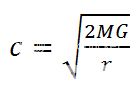
where c is the velocity of light in a vacuum (and the velocity you would have to exceed to escape a black hole), M is the mass of our black hole universe, G is the Newtonian gravitational constant and r represents the radius of our black hole universe.
Before going any further, life is easier without that square root sign. Squaring both sides of the equation gives:
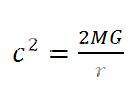
Moving things around the equals sign then gives:
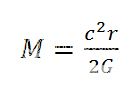
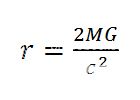
If you have followed this so far then you will be delighted to know that if you make a tiny notational change and replace r with rs
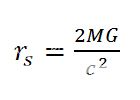
then you just wrote down and understood the equation for calculating the radius of a Schwarzschild (non-rotating) black hole. Sorry for sharing that, but I thought it may be the sort of thing some of the people here might get a kick from too.
3) RESULTS:
So, with the exciting bit over, the only thing that remains is programming your spreadsheet to plug some numbers back into the equation. Here is what I got back:
Scenario 1: (Implausible)
In order to be consistent with the current estimate of 9.3x10^10 light years for the diameter of the observable universe, a Schwarzschild black hole would have a mass of 2.965 x10^53 kg and a density of 8.29 x10^-25 grams per cubic centimetre. This is greater than the critical density of the universe (approximately 1 x10^-29 grams per cubic centimetre) and thus describes a contracting universe.
This could also be interpreted as an indication that our observable universe is only a small part of a much larger universe. We just cannot see the bits that are moving away from us faster than light speed.
Scenario 2: (Implausible)
Current total mass/energy estimates for the observable universe (matter + dark matter + dark energy) scale to a Schwarzschild black hole with a mass of 3.06 x10^54 kg, a diameter of 9.61 x10^14 light years and a density of 7.78 x10^-27 grams per cubic centimetre. This exceeds the critical density of the universe (~ 1 x10^-29 grams per cubic centimetre) and thus describes a contracting universe.
This should not be taken as a statement to the effect that current total mass/energy estimates for the universe are wrong. What the statement implies is that if the mass/energy conditions measured in our observable universe were uniform across the interior of a (by necessity far larger) Schwarzschild black hole, we would observe a collapsing universe as opposed to an expanding one.
Scenario 3: (Plausible?)
A Schwarzschild black hole with a mass of 8.58 x10^55 kg and diameter of 2.69 x10^16 light years would be consistent with the density of our universe, which is currently measured at 9.9 x10^-30 grams per cubic centimetre.
This is consistent with an expanding universe as it is lower than the critical density of our universe (~ 1 x10^-29 grams per cubic centimetre).
By setting the density of a Schwarzschild black hole model to the observed value of matter density, this calculation (unlike the two previous calculations) is not subject to the restrictions imposed by estimates of the size/mass of the observable universe.
If this is what our universe is like then we live in a patch of above average mass/energy density inside a Schwarzschild black hole approximately three million times the size of the part we can actually observe.
If it is a single object on a superhorizon scale then it raises so many questions (What the hell does Hawking radiation emitted from a universe entail? Do things like entangled but causally disconnected patches of spacetime reduce the universal principle that simultaneity is strictly a localised phenomenon to a strictly localised principle? Is this the EPR paradox rearing that ugly wormhole of a head yet again? Can I finally try eating meat again today?) that it is making my brain hurt, so this is where I check out.
I still have no idea if we live in a black hole or not, but I hope you have at least been entertained by my at least entertaining the idea.











